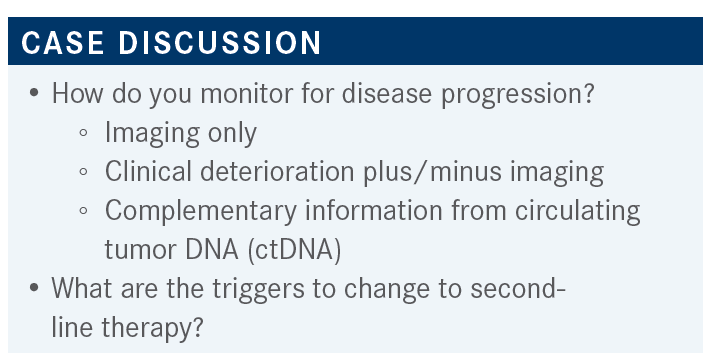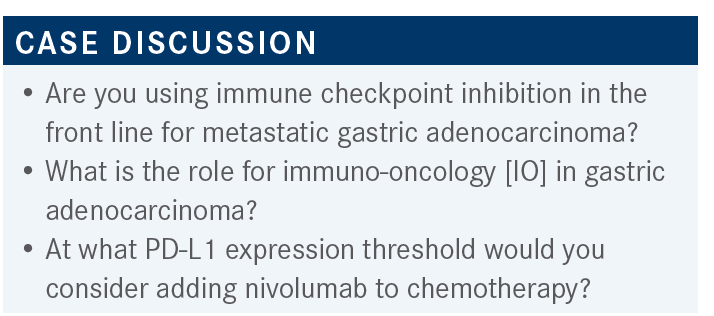Roundtable Discussion: Ajani Leads Debate on Molecular Testing in Gastric Cancer
Jaffer A. Ajani, MD led a discussion around biomarkers to consider when determining systemic therapy for patients with stage IV gastric adenocarcinoma.
Jaffer A. Ajani, MD

Biomarkers to consider when determining systemic therapy for patients with stage IV gastric adenocarcinoma was the topic of discussion during a recent Targeted Oncology Case-Based Roundtable event moderated by Jaffer A. Ajani, MD, professor, Department of Gastrointestinal (GI) Medical Oncology, Division of Cancer Medicine, The University of Texas MD Anderson Cancer Center.
Dr. Ajani was joined by Ashwani K. Agarwal, MD, Arvind Bhandari, MD, Jagathi Devi Challagalla, MD, Dilip l. Solanki, MD, and Yixing jiang, PhD, BM.

AJANI: One of the things I want to discuss with all of you is the issue of molecular testing. I first want to mention that when this sort of patient arrives in the clinic and has received an endoscopy, we’re talking about tiny biopsies. Many gastroenterologists in the practice will go in there, see something abnormal, take a couple of biopsies and they come out, then that’s all you have. That amount of tissue is not sufficient to make an HNE [4-hydroxynonenal] diagnosis. Maybe do diagnostic immunohistochemistry [tests], or do biomarker [testing] that may help you with treatment decisions. It’s becoming a larger issue as to how you prioritize the biomarkers; the list just keeps getting larger.
AGARWAL: For all my patients with metastatic disease, I’m doing the next-generation sequencing [NGS] panel for multiple] biomarkers, because [certain biomarkers] can be treated in a different way. I’m also doing liquid biopsies in all these patients, both the NGS panel and liquid biopsy, because the targetable mutations can really make a difference in the [treatment] of these patients.
AJANI: If you have tissue limitations, then can you tell us your priority?
AGARWAL: If I have tissue limitations, I just do the PD-L1 test. Because we cannot do [that] on liquid biopsies. For everything else, I’d defer to liquid biopsy. But sometimes I’ve done repeat biopsies also if there’s a tissue limitation. And I try to do HER2 testing on the tissue biopsy.
The sensitivity is not as great with the liquid biopsy, I think. But still, I think we can pick up almost 75% to 80% of these targetable mutations. The studies are not very profound yet, or very robust in the liquid biopsy setting, but I think we can still pick up a lot of those mutations.
I’m very aggressive sometimes in doing repeat biopsies because if I’m not satisfied, I’m not treating any of these patients without having a full NGS panel.
AJANI: The FoundationOne [CDx test] got FDA approval for much larger features. There are 309 [cancer-related genes tested] in the liquid biopsy. Some of my patients are sending me those reports. But that is much larger than the Guardant360 test, which is 70 [genes]. These platforms are going to get much better and will probably provide a lot of information. Sometimes [these are] helpful in triaging these patients to phase 1 trials.
AGARWAL: My question is [why] 360? Five or 6 is all I need. When I see 360—200, 300 genes—I get confused. I’m happy with a smaller biopsy panel, the ones that can be targeted. Three hundred sixty is good, but that may be more for research purposes and if you have a protocol or something. But for clinical practice, I’m just looking for these 6 or 7 things, which I can target.
AJANI: I fully understand. But we would like a larger panel without a higher cost, so you get more [genes] that are interrogated and [necessities like] microsatellite instability and tumor mutational burden [TMB] will be there. Plus, you might get some other targets or drivers that could help refer the patient [to a specialist].
BHANDARI: Our pathologists say that if you order these tests individually, then you need more tissue. Even though I agree with Dr Agarwal that I would like to see just a small number of tests that we’re going to use in our practice, from the standpoint of doing the test, from what I’m told, if we order 3 or 4 tests individually they have to send 3 or 4 different samples. But they can do the full NGS FoundationOne panel on 1 sample. Is that true?
AJANI: Yes, if you read the National Comprehensive Cancer Network [NCCN] recommendations, there is a separate section.1 It’s just a matter of prioritization. Everybody’s struggling with the amount of tissue—you can biopsy a metastatic site, which is not practical, and you can repeat biopsy, which we also do sometimes. But I think that for an untreated patient, the critical information you want is probably HER2 and PD-L1 status, which will also become important in the first line. Then microsatellite instability/stability status would be desirable, but approval [for the targeted agent] is for second line. TMB is high in only 10% of patients. Epstein-Barr virus is rare in metastatic disease, and so on.

AGARWAL: I’d only rely on the radiological data, but I do look at the tumor markers….I combine it with clinical data also, and their performance status. If the patient is deteriorating, I’m always worried about progression. It’s not a computer model of these kinds of assessments. That’s why I feel oncologists will still have a job.
AJANI: I think you’re right. What do you do with somebody who [progressed] on first-line treatment? Somebody who has been on for 6 months and they have slight progression? Do you jump into second line or give them a break?
AGARWAL: If I see any sign of progression, for me, it’s not slight progression. It’s maybe 25% progression. For me, it’s progression or no progression. I make it quite black and white. If I see any sign of progression and deterioration in clinical status, I move into the second line. It’s a tough disease to treat in the metastatic setting.
CHALLAGALLA: It’s not the size of the lesion as much as [if there are] new lesions and you can say unequivocally the patient has progressed.
Regarding ctDNA, I am not sure whether we are at that stage where we see the ctDNA and start changing treatment. It’s useful, but I don’t know whether we have as much data where we can move forward based on just that.
AJANI: I agree with you. I’m not recommending to any one of you to do ctDNA and make a decision on that. I’m just curious about what your experiences are.
SOLANKI: How sensitive a test you use to make a next treatment decision depends on what your next treatment is and what your expectations from it are. A classic example is testicular cancer, where we treat based on markers because we have such good therapy and outcomes. I’m not sure that second-line metastatic gastric cancer approaches anywhere near that.
My own feelings depend upon the individual patient. You can use the least amount of interventional studies to get information. For example, if the only site of metastasis was lung nodules, you could do chest x-ray without doing CT scans all the time, or you could follow liver chemistries and use tumor markers to tell you to do studies. [I don’t think] doing a set schedule of scans…is particularly helpful. In the community setting, every patient will get a PET scan. I can guarantee you that.
AJANI: I think you are making some good points. First, even frontline treatment [in this setting] is not earth-shattering. It’s an incremental advantage, but still almost every patient has progression, second-line treatment is not all that good, and third line is even worse. You’re right; these patients usually get more symptomatic as they enter the second and third lines. They have higher tumor volume and more symptoms, and we have less effective treatment for them. It’s a real challenge, and I think it’s going to take a while to get to [the treatment we have in] testicular cancer.

AJANI: Are you already starting to use drugs like nivolumab [Opdivo] in the front line based on data presented at the European Society for Medical Oncology Congress? Is anybody using nivolumab with chemotherapy for metastatic gastric cancer in the front line?
JIANG: Yes, we tried to use it, but one challenge is that sometimes when you start a chemotherapy, then you must wait until the PD-L1 CPS comes back. That will take a bit of time, so [we are] not jumping into therapy right away. You’re probably starting with some form of a chemotherapy and when you have the data available, then you might add IO in the near future.
AJANI: I think that’s a beautiful point because HER2 testing—also in my own institution—can take more than a week [to come back], and when some patients are arriving, they are very symptomatic. If you look at the American Society of Clinical Oncology [ASCO] and the College of American Pathologists guidelines published in the Journal of Clinical Oncology, it clearly says you don’t need to wait for your HER2 test.2 You can start chemotherapy and then, when you get the HER2 status, you can add trastuzumab [Herceptin]. I think we should probably have to do the same for when we are thinking about nivolumab—to go ahead and start chemotherapy, and then, when PD-L1 is back, then you decide whether to add nivolumab or not. Right now, you can get it from Bristol Myers Squibb, or you can argue with the insurance, and some insurance companies are approving it because it’s listed in the NCCN guidelines.1
CHALLAGALLA: I tried [the insurance] for CPS; it was not greater than 5% and I got rejected there.
AGARWAL: Insurance is a big issue. We are not giving anything unless we have full insurance approval because the problem sometimes is [that] they approve it and then they can deduct it from the subsequent [bill], saying that it was not on the guidelines or something.
We are very careful in giving anything without approval, beyond the standard of care. We are basically trying to cross all the T’s, dot all the I’s before we give patients anything.
SOLANKI: If you don’t have evidence, you can’t assume that is evidence. If less than 5% [PD-L1 score] was not tested, we tend to assume that it should be OK, but that’s not evidence-based. I’ll always wonder about things like HER2-positive breast cancer; they approved therapy for 2-cm [tumors], but 1-cm tumors are not tested. Can we assume that they would benefit? It’s the same situation here—if we don’t have evidence, then insurance companies are going to all [deny it].
AJANI: How many people are using fluoropyrimidine and a platinum compound as front line, and is anybody adding a third drug, like docetaxel in metastatic setting, or does anybody prefer FOLFIRI [folinic acid, fluorouracil, irinotecan]?
AGARWAL: I just use FOLFOX [folinic acid, 5-fluorouracil (5-FU), oxaliplatin].
JIANG: I use modified docetaxel, cisplatin, and 5-FU every 2 weeks. That is quite tolerable, and in gastric cancer I think a taxane is a very effective drug in addition to the 5-FU–based chemotherapy. FLOT [5-FU, folinic acid, oxaliplatin, docetaxel] is used in the perioperative setting… sometimes I use that too.
AJANI: When we have nivolumab approved, I don’t think insurance companies will allow you to use 3 drugs. The NCCN panel, which is [about] 36 comprehensive cancer institutions, doesn’t recommend use of taxane in the front line because the advantage is very minor. You just add toxicity.
AGARWAL: I never use taxane for front line.
JIANG: There was [a study] conducted using FOLFOX as a backbone, because it’s also a very popular regimen in practice. That’s also one of the reasons, I think.
AJANI: You make the tumor resistant to taxane when you’re jumping into second line. There are studies already showing that if you use taxane in front line and again in second line, you lose that advantage. This is an ongoing debate, but the data are old. There are no new trials of 3 cytotoxic drugs. Everybody’s abandoning it because 2 drugs makes a very good platform for adding new drugs that we are interested in.
AGARWAL: In any metastatic disease, I’m not a fan of 3 drug combinations. Like in breast cancer, there is enough data with single agent—in fact, it’s a bold question, in metastatic breast cancer, you only use single-agent drugs one after the other. I don’t think in any metastatic disease setting [that] I’ve used 3-drug combinations because these people will see second- and third-line therapy. I’m always looking for NTRK fusion or something else that might pop up and can make [treatment easier].
References:
1. NCCN. Clinical Practice Guidelines in Oncology. Gastric cancer, version 2.2021. Accessed April 6, 2021. https://bit.ly/31QtZAS
2. Bartley AN, Washington MK, Colasacco C, et al. HER2 testing and clinical decision making in gastroesophageal adenocarcinoma: guideline from the College of American Pathologists, American Society for Clinical Pathology, and the American Society of Clinical Oncology. J Clin Oncol. 2017;35(4):446-464. doi:10.1200/JCO.2016.69.4836
